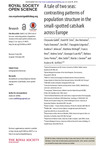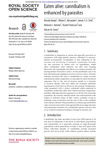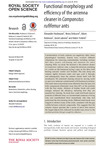Search
Now showing items 31-40 of 144
Ataleoftwo seas: contrasting patterns of population structure in the small-spotted catshark across Europe
(The Royal Society, 2014)
Elasmobranchs represent important components of marine ecosystems, but they can be vulnerable to overexploitation. This has driven investigations into the population genetic structure of large-bodied pelagic sharks, but ...
Competition and cooperationina synchronous bushcricket chorus
(The Royal Society, 2014)
Synchronous signalling within choruses of the same species either emerges from cooperation or competition. In our study on the katydid Mecopoda elongata, we aim to identify mechanisms driving evolution towards synchrony. ...
High atmospheric temperatures and ‘ambient incubation’ drive embryonic development and lead to earlier hatching in a passerine bird
(The Royal Society, 2016)
Tropical and subtropical species typically experience relatively high atmospheric temperatures during reproduction, and are subject to climate-related challenges that are largely unexplored, relative to more extensive work ...
Males migrate farther than females in a differential migrant: an examination of the fasting endurance hypothesis
(The Royal Society, 2014)
Patterns of migration including connectivity between breeding and non-breeding populations and intraspecific variation in the distance travelled are important to study because they can affect individual fitness and population ...
Eaten alive: cannibalism is enhanced by parasites
(The Royal Society, 2015)
Cannibalism is ubiquitous in nature and especially pervasive in consumers with stage-specific resource utilization in resource-limited environments. Cannibalism is thus influential in the structure and functioning of ...
Tiarajudens eccentricus and Anomocephalus africanus, two bizarre anomodonts (Synapsida, Therapsida) with dental occlusion from the Permian of Gondwana
(The Royal Society, 2015)
Anomodontia was a highly successful tetrapod clade during the Permian and the Triassic. New morphological information regarding two bizarre basal anomodonts is provided and their palaeoecological significance is explored. ...
Familiar and unfamiliar face recognition in crested macaques
(The Royal Society, 2015)
Many species use facial features to identify conspecifics, which is necessary to navigate a complex social environment. The fundamental mechanisms underlying face processing are starting to be well understood in a variety ...
Amodel for non monotonic intensity coding
(The Royal Society, 2015)
Peripheral neurons of most sensory systems increase their response with increasing stimulus intensity. Behavioural responses, however, can be specific to some intermediate intensity level whose particular value might be ...
Leaf processing behaviour in Attaleafcutter ants
(The Royal Society, 2015)
Leafcutter ants cut trimmings from plants, carry them to their underground nests and cut them into smaller pieces before inoculating them with a fungus that serves as a primary food source for the colony. Cutting is ...
Functional morphology and efficiency of the antenna cleaner in Camponotus rufifemurants
(The Royal Society, 2015)
Contamination of body surfaces can negatively affect many physiological functions. Insects have evolved different adaptations for removing contamination, including surfaces that allow passive self-cleaning and structures ...










